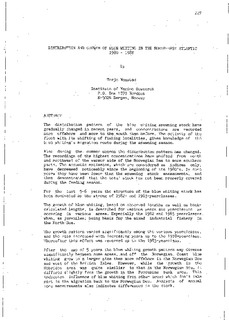| dc.description.abstract | The distribution pattern of the blue whiting spawning stock have
gradually changed i n recent years, and concentrations are recorded
more offshore and more to the south than before. The activity of the
fleet with its shifting of fishing localities , gives knowledge of the
blue whiting's migration route during the spawning season.
Also during the summer season the distribution pattern has changed.
The recordings of the highest concentrations have shifted from north
and northwest of the warmer side of the Norwegian Sea to more southern
parts. The acoustic estimates, which are considered as indices only,
have decreased noticeably since the beginning of the 1980's. In some
years they have been lower than the spawning stock assessments, and
thus demonstrated that the total stock has not been properly covered
during the feeding season.
For the last 5-6 years the structure of the blue whiting stock has
been dominated by the strong of 1982- and 1983-yearclasses.
The growth of blue whiting, based on observed lengths as well as backcalculated
lengths, is described for various years and yearclasses as
occuring i n various areas. Especially the 1982 and 1983 yearclasses
when, as juveniles, being basis for the mixed industrial fishery in
the North Sea.
The growth pattern varied significantly among the various yearclasses,
and the rate increased with increasing years up to the 1978-yearclass.
Thereafter this effect was reversed up to the 1983-yearclass.
After the age of 5 years the blue whiting growth pattern may diverse
significantly between some areas, and off the Norwegian Coast blue
whiting grow to a larger size than more offshore i n the Norwegian Sea
and west of the British Isles. However, while the growth i n the
Hebrides area was quite similiar to that in the Norwegian Sea, it
differed slightly from the growth in the Porcupine bank area. This
indicates influence of blue whiting from other areas which don't take
part in the migration back to the Norwegian Sea. Analysis of annua1
zone measurements alco indicates differences in the stock. | en |
